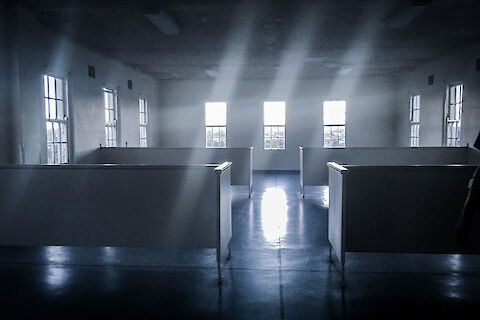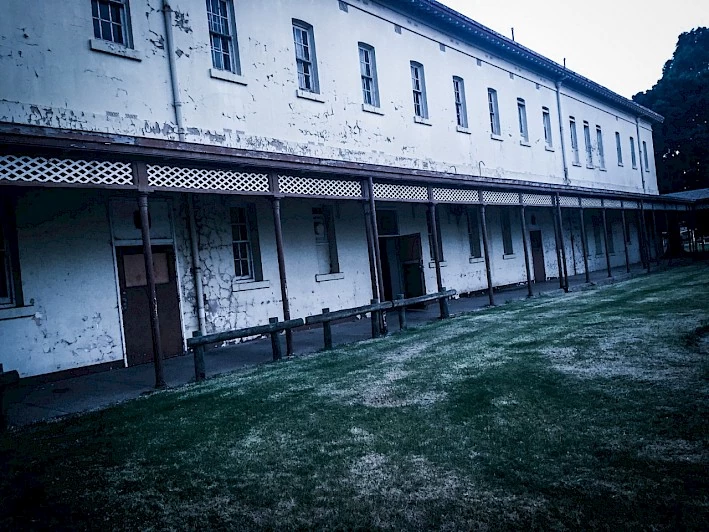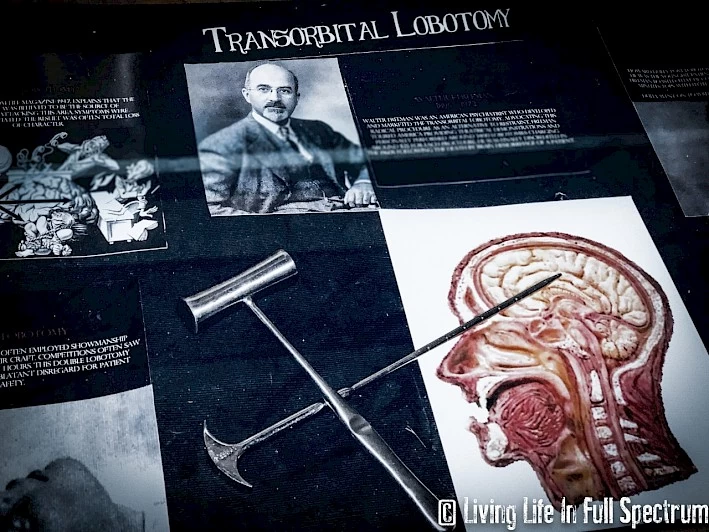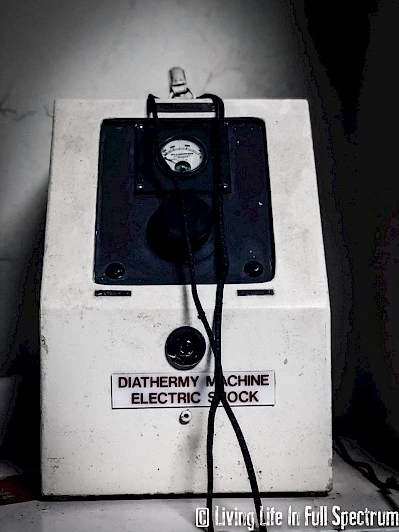

Aradale Lunatic Asylum was opened in 1867 and operated for around 130 years. Some of the world’s most controversial psychiatric procedures were conducted in an attempt to treat misunderstood mental illnesses. It consisted of around 68 buildings and had over 2000 patients and staff (there were 500 staff alone). It ran itself as a self sufficient town. A distinctive feature of the asylum is the use of a variation on Ha Ha walls which are around the courtyards. From the inside, the walls look very tall and are impossible to climb to escape. From the outside, the walls didn’t look very high so it didn’t suggest the imprisonment that the patients were subject to. It took only 2 signatures to have someone committed, and at one point in time it took up to 8 signatures to be released meaning that most people did not get to leave the asylum. It is documented that around 13000 people died at the asylum with some considering it to be one of Victoria’s most haunted locations. Aradale was closed in 1998 and in 2001 it became a campus of Melbourne Polytechnic.

Photo by Sarah @ Living Life In Full Spectrum
The asylum in Ararat has become the major attraction to this small little town. Along with its sister J Ward up the road, patrons have an opportunity to learn all about the controversial past of these buildings and even look for a 'ghost' or two. Dark tourism is a big thing these days and it is important to understand that the focus here is on preserving history. There is often debate in communities as to whether or not dark tourism is OK and if exploring these kinds of places is disrespectful based on some of the atrocities that occurred within its walls. In this particular case, there is always an intrigue and fascination with what actually happened. I personally am often contacted by people who had relatives in Aradale when it was a functioning asylum and they want to go and visit to learn more about it. Some have even invited me to come with them! What an honour! While it can be confrontational for some, when it is done with respect and integrity, people often find the closure they need and are thankful to be given the opportunity to see the buildings and learn about what went on. The town itself openly welcomes visitors to the asylum as the local businesses benefit significantly from people visiting. While some would rather we forget our past, it is important that we remember so that we can not only learn from our mistakes but also respect those who lost their lives in the process. Aradale was not without its criticism. It used some of the most controversial procedures in the world to 'treat' and restrain their patients.
In the museum at Aradale, you can gain a glimpse into some of these procedures.
Lobotomies
A lobotomy is also referred to as a leucotomy. It is a neurosurgical procedure to sever the connections to the brain's prefrontal lobe. The thought process was that if you could damage these connections to the brain, you could stop bad behaviours caused by conditions such as bipolar, schizophrenia, manic depression and other mental illnesses. In the 1880s, a Swiss physician by the name of Gottlieb Burkhardt claimed that he had removed parts of the cortex from the brains of patients who were suffering from auditory hallucinations stemming from schizophrenia. Even though a patient died from this procedure and another committed suicide after, he deemed it a success in calming patients.

In 1935, Portuguese neurologist Antionio Egas Moniz was credited with inventing the 'lobotomy', performed what they considered to be successful trials on chimpanzees and then went on to test on human subjects. While they claimed this procedure was a success, the side effects included fever, vomiting, bladder and bowel incontinence eye problems, fatigue and apathy. Some were literally turned into vegetables. Not to mention that the procedure was often done without any anesthesia.
The initial procedures were performed by cutting a hole in the skull and injecting ethanol into the brain to destroy the fibres that were connected to the frontal lobe from other parts of the brain. Later Moniz invented a surgical instrument called a leucotome which had a loop of wire that when rotated, would create a lesion on the brain.
The transorbital lobotomy is probably the most common procedure people associate with the term lobotomy. Italian physicist Amarro Fiamberti developed a procedure that accessed the frontal lobe through the eye sockets. This inspired Walter Freeman and James Watts to develop the transorbital lobotomy also known as the Freeman-Watts method. An instrument similar to an ice pick called an orbitoclast would be inserted through a patient's eye socket using a hammer. It was marketed as a fast incision-free 'surgery' that didn't need to be performed by a qualified doctor. Freeman himself was considered a 'showman'. He travelled around the US performing and demonstrating lobotomies at mental institutions. He would chew gum and didn't wash his hands as he wasn't concerned with hygiene. He could perform the surgery in less than 10 minutes and sometimes would hold an ice pick in each hand to do both eyes simultaneously. He had a 14 per cent fatality rate and performed close to 3500 lobotomies. It was quite literally a hit-and-miss procedure.
Lobotomies were prevalent in mental institutions and used as a way to control unruly patients - including Aradale. In the 1950's scientists developed antipsychotic and antidepressant medicine which were found to be much more humane and effective and lobotomies were phased out and are now illegal in several countries for obvious reasons.
It should come as no surprise that when guests enter the rooms at Aradale where this procedure was performed, many complain of a sharp headache. Often they are unaware that this is the space where this procedure was performed when highlighting their sudden headaches.
Electroshock Therapy
Also referred to as ECT, this procedure was developed in 1938. Electrical currents are circulated through the brain with the theory that the current can affect the brain's electrical activity in a way that can lessen symptoms of a person suffering from psychotic and depressive symptoms. It is a procedure that is still used today in a hospital where today a patient is given a muscle relaxant and put under a general anesthetic. The current induces a seizure however the patient does not convulse due to the muscle relaxant. They wake up a little groggy but most importantly pain-free and clear-headed 30 minutes afterwards.

It is safe to say, however that in the 30s and 40s when this was unregulated, the procedure was not performed under such controlled and comfortable conditions for the patient. ECT was invented in the late 1930s in Italy. Psychiatrists found that by inducing seizures, they could relieve some of the symptoms associated with mental illness. Using a chemical called Metrazol, they would induce a seizure in a patient. It caused a lot of fear for the patient and there were often reports of nurses and doctors chasing patients around a room to give them the medicine. Researchers suggested a more humane way would be to induce the seizure via an electrical current. During the time in which it was unregulated, it was suggested that a lot of mental hospitals used it as a way to control or punish a patient. A scene from the movie 'One flew over the cuckoo's nest' is ingrained in our memories as to how this procedure may have been administered. While Hollywood does have a tendency to over-exaggerate things, one can only wonder how real of a depiction it really was. What we do know is that ECT was one of the leading treatments used at Aradale and other mental institutes all over the world.
With a women's and men's hospital on site, there were more procedures forced upon patients - often without anesthesia and without the patient's consent. While we have moved on from these mistakes to the past, it is important to recognize how far we have come in the treatment of mental illness and humans in general and offer our respect to those who were subject to some of the horrible procedures.
-------------------------------------------------------------------------------------------------------------------------------------------------------
If you would like to visit Aradale and learn more about the historical side with a ghost tour or extended paranormal investigation, visit Eerie Tours.
If you enjoy LLIFS, consider buying me a book (otherwise known as buy me a coffee but I don't drink coffee and I LOVE books). Your donation helps to fund the LLIFS website so everyone can continue to access great paranormal content and resources for FREE!

Top pages with similar subjects
Don't forget to follow the Facebook page for regular updates
Join the mailing list to receive weekly updates of NEW articles. Never miss an article again!
Buy the latest and past issues Haunted Magazine
Check out the books written by LLIFS
Comments
-
Sarah 5 years ago
Wow and omg love to hear these stories as I'm doing a cert 4 in mental health we have to study asylums there sooo facinating but sad at the same time !
-
Clea 3 years ago
Sarah , re lunatic asylums, you may be interested to read my great grandfathers account of Kew Lunatic Asylum, Victoria, Aust. Dr Paul Ward Farmer, committed by his colleagues.
http://digital.slv.vic.gov.au/view/action/singleViewer.do?dvs=1622020861945~296&locale=en_US&metadata_object_ratio=10&show_metadata=true&VIEWER_URL=/view/action/singleViewer.do?&preferred_usage_type=VIEW_MAIN&DELIVERY_RULE_ID=10&frameId=1&usePid1=true&usePid2=true Three Weel
-
-
Pauline fisher 5 years ago
Pauline fisher: My Uncle Joseph live at Aradale back 1990 he drowned at the Addatore across from Aradale 3 ins of water face down. Live there from 22/9/38 - 1990 he was up in T.C. 5 . We been to Aradale years ago and too see Aradale see if Joe is still here in upstairs..
-
Katherine Juryga 5 years ago
I used to live at Aradale from 1981-1988. My father was one of the head psychiatrists there at the time and we lived on the grounds. I have lots of interesting memories from back then!!
-
Living Life In Full spectrum 5 years ago
Oh wow yes you would have some amazing stories I’m sure
-
-
jeanette kirk 5 years ago
My grandmother died theye in 1962 didnt know about her till searching family history in 2004 she was misdiagnosed many years before as being insane had a toxic thyroid as symptons can be the same she buried in the Beechworth cemetery in a paupers grave
-
LIVING LIFE IN FULL SPECTRUM 5 years ago
I am so sorry to hear that. As someone who has Hashimotos Thyroid disease and other problems which would have been considered as 'Hysteria' I can sympathise. I am glad you were able to find some information on her so she can be remembered.
-
-
Joshua Grove 5 years ago
I used to work as a security guard for the worlds oldest known koala sanctuary. Lone Pine koala sanctuary in Brisbane. Story goes a woman once drowned herself in the fountain in three feet of water. I kept getting asked if id seen her ghost until one night i did. We had a breif conversation telepathically as i am a medium, then she disapeared. I can take you to meet her if youd like. She had an old school dress on with the wire bum. This is not a hoax.
-
LIVING LIFE IN FULL SPECTRUM 5 years ago
What an interesting story! I am from Melbourne but if I am ever up Brisbane way I would love to have a look!
-